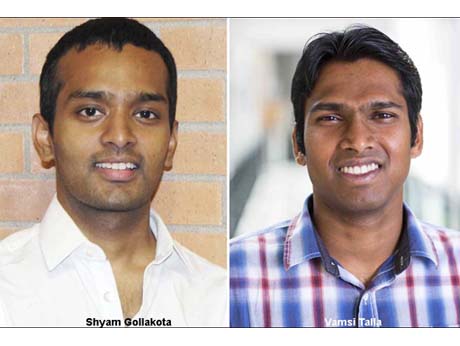
They reduce power requirement to a tiny fraction of what is used today -- and harvest that from radio signals and ambient light
July 14 2017: Can we imagine a battery-free cell phone that operates while consuming only a few micro-watts of power? This would enable mobile phones to communicate without the need for batteries. They could in principle derive this very small power from cheap and lightweight sources like radio signals and photodiodes instead of bulky and expensive solar cells. The challenge lies in the fact that a mobile phone is required to perform multiple basic operations: sensing speech at the device, transmitting it to the base station, receiving speech information from the base station and finally actuating the speaker/earphones. Can it perform all these functions, in real time, using only a few micro-watts of power?
Scientists at the University of Washington -- including two Indians -- have given the answer: yes it can be done! And in the June issue of the Proceedings of the ACM ( Association of Computer Machinery), they describe how they did it -- culminating in a first-ever Skype call over a mobile network from a battery-free phone. Using commercial-off-the-shelf components on a printed circuit board, they created a prototype of a cell phone without battery, that operated on power that is harvested from Radio Frequency signals transmittedby a mobile base station about 10 metres away. They supplemented this power by harvesting power from ambient light using tinyphotodiodes.
---------------------------------------------------------------------
For product images, see Image of the Day
---------------------------------------------------------------------
The lead of 4 authors of the paper is Vamsi Talla, an alumnus of Delhi Public School, Panipet refinery and a B.Tech from IIT Guwahati who went on to do his MS and PhD in Electrical Engineering at Washington State University in the US. Today Talla is the CTO of Jeeva Wireless which is revolutionizing wireless communication by enabling connectivity at a fraction of the cost, size and power of existing approaches.
Talla's co-author and co-researcher is Shyam Gollakota, alumnus of IIT Madras, who did his MS and D at MIT, US and is associate professor in the Department of Computer Science and Engineering at the University of Washington where he leads the Networks and Mobile Systems Lab. With Talla he is a cofounder of Jeeva Wireless.
The other two authors are University of Washington faculty lead, Prof Joshua Smith and Bryce Kellogg, a UW electrical engineering doctoral student.
Says Gollakota: “We’ve built what we believe is the first functioning cellphone that consumes almost zero power. To achieve the really, really low power consumption that you need to run a phone by harvesting energy from the environment, we had to fundamentally rethink how these devices are designed.”
Their rethink led to this: They eliminated the most power-hungry step in most mobile phones — converting analog signals that convey sound into digital data that a phone can understand. This process consumes so much energy that it’s been impossible to design a phone that can rely on ambient power sources -- till now, that is. Instead, their battery-free cellphone took advantage of tiny vibrations in a phone’s microphone or speaker that occur when a person is talking into a phone or listening to a call. An antenna connected to those components converts that motion into changes in standard analog radio signal emitted by a cellular base station.
To transmit speech, the phone uses vibrations from the device’s microphone to encode speech patterns in the reflected signals. To receive speech, it converts encoded radio signals into sound vibrations that that are picked up by the phone’s speaker. In the prototype device, the user presses a button to switch between these two “transmitting” and “listening” modes.
The team designed a custom base station to transmit and receive the radio signals. But in a real life situation, that technology could be integrated into standard cellular network infrastructure or Wi-Fi routers..
Adds Vamsi Talla: “You could imagine in the future that all cell towers or Wi-Fi routers could come with our base station technology embedded in it. Iif every house has a Wi-Fi router in it, you could get battery-free cellphone coverage everywhere.”
Their battery-free phone prototype does still require a small amount of energy around 3.5 microwatts -- but this is a tiny fraction of what phone batteries are delivering today.
Having proved that you can get away with this tiny power, what next? The research team plans to improve the battery-free phone’s operating range and encrypting conversations to make them secure. The team is also working to stream video over such a phone.
------------------------
Battery-Free Cellphone:
VAMSI TALLA, BRYCE KELLOGG,SHYAMNATH GOLLAKOTA AND JOSHUA R. SMITH. Proceedings of the ACM on Interactive, Mobile, Wearable and Ubiquitous Technologies Volume 1 Issue 2, June 2017 Article No. 2.